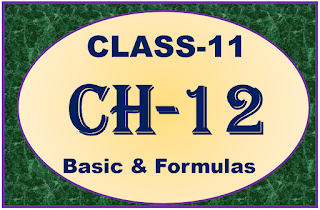Featured Posts
Basics & Formulas Ch-12 Class11 | Limit and Continuity
- Get link
- X
- Other Apps
Limit and Continuity Class 11
Introduction
Limit and continuity is the introduction of calculus. Calculus is
that branch of Mathematics which mainly deals with the study of change in the
value of a function as the point in the domain changes.
Definition:
Suppose f is a real function on a subset of the real numbers and let c be a point in the domain of f. Then f is continuous at c if
Undefined terms:
all these terms are called undefined terms
Left Hand Limit and Right Hand Limit
If at any point c given function have two different values then at that point (c) we calculate LHL and RHL. and the limit exist if
Left Hand Limit = Right Hand Limit = f(c)
LHL is denoted by
RHL is denoted by
When limit exist then
For a function f(x) the limits and
may or may not exist
If both limits and
exist, they may not be equal.
If then
does not exist
If , then
exist and is equal to the common limit.
A function is said to be continuous if its limit exist or if or if
Left Hand Limit = Right Hand Limit = f(c)
EVERYWHERE CONTINUOUS FUNCTION
Constant Functions
Exponential Functions
Polynomial Functions
Modulus Functions
Rational Functions
Trigonometric Functions
Logarithmic Functions
EXPONENTIAL LIMITS
Here we use the series
LOGARITHMIC LIMITS
Here we use the series:
, where a > 0
THANKS FOR YOUR VISITPLEASE COMMENT BELOW
- Get link
- X
- Other Apps




Comments
Post a Comment